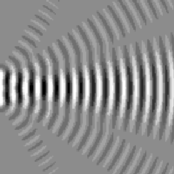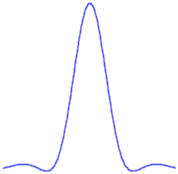



At this minimum, the phases from the different portions of the slit must cancel. Since the slit produces a continuous range of phases, the contributions will cancel out if all phases are weighted equally. (The average of sin(x + phi) when phi varies over two pi is zero.) This happens if the two ends of the slit have phases which differ by 2 pi: that is, the condition that a slit of width a has a minimum is that the two ends of the slit interfere constructively. (Isn't that perverse?) Give the formula for the angle of this first minimum, without using the small-angle approximation. Calculate the distance you predict for the minimum, and compare with your prediction.
Notice that the minima in the pattern are roughly equally spaced, except that the central peak is twice the width of the others. If the phase from the slit varies by 2 m pi over the width of the slit, then all phases are weighted equally. Explain in your write-up why is this not true for m=0, the central peak.
Make the wavelength larger. At Lambda=1, use Screen size to increase the screen size to 300m, and use configure... to change Wave-tank Size L to 30. Can you see the beams emitted corresponding to the central and side peaks? For Lambda=10, how different is the pattern on the screen for a=1 from that for a=0?
Geometrical optics, which is the science which allowed us to design lenses, microscopes, and telescopes, is precisely the ``straight-line'' behavior of waves in vacuum when they have very short wavelengths compared to the obstacles in their path. Geometrical optics ignores diffraction, and treats light as being composed of rays.
![]() Statistical Mechanics: Entropy, Order Parameters, and Complexity,
now available at
Oxford University Press
(USA,
Europe).
Statistical Mechanics: Entropy, Order Parameters, and Complexity,
now available at
Oxford University Press
(USA,
Europe).